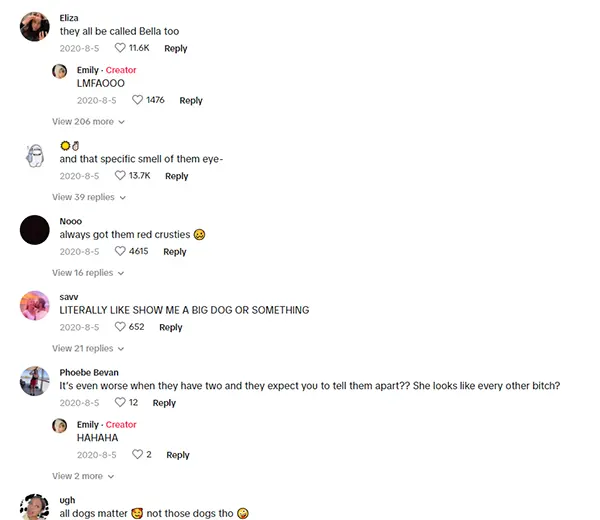
What are Crusty White Dogs?
You have Bulldogs, Dachshunds, Great Danes, Pit Bulls, Golden Retrievers, Pugs, and Corgis, which are all charming dog types. On the other hand, some are just clearly the worst.
The worst dog breeds on this list are chihuahuas, which are known to be hyperactive and mean. But coming in second is a breed of dog that isn’t talked about very often, even though everyone knows what kind of dog it is just by reading about it.
You know the exact dog I mean when I say “those fluffy white dogs with the crusty eyes,” right? The dogs with the red, crispy eye marks or the black, gooey stuff around their eyes? As a kid, it seemed like every rich girl had one of those. That was always called “Bella” or “Coco,” but no one knows why. And do it while living much longer than any other animal?
Yes, those dogs. Well, most of the time, they’re Maltese Terriers, and finally, online, people are coming together to hate the little round-eyed dogs.
In the past few weeks, a lot of people on TikTok have been making fun of the crusty old white dogs.
Videos on the app have kept going around about how the breed has an awful smell, eyes that are always dirty, and a strange ability to keep avoiding death. #crusty white dogs

But the dislike of the dog breed has spread to Twitter, where people are happy that other people are finally being honest about how much they dislike Maltese dogs.
It’s not that people want to hate dogs, but those dirty white ones are a choice. Dog Time says that the “gentle” but “sprightly” mood of Malteses makes them very popular. This makes them great for families with children. They’re also small and hypoallergenic, which is another benefit for people who want a dog but are still determining if they should get one.
People who own Coco or Bella are also trying to protect their dogs on TikTok, even though everyone is making fun of these crusty, fluffy white boys.
Do not worry if you have a Maltese. You are not the only one. I mean, you could not possibly be alone since everyone else has one.
Crusty White Dogs Meme

People first talked about the “crusty white dog” on Twitter, and then the news spread to TikTok. People have noticed a certain kind of small white dog that lives with wealthy white families or in the homes of grandparents. This joke is based on that observation. The crusty white dog meme has been going around for a while and keeps getting more and more famous.
Certain types of dogs often get stains, mucus, or crust in their eyes, which is what crusty white dogs are. Some people might not like how they look because of this. But, even so, a lot of people still think these dogs are cute! Shih Tzu, Maltese, Bichon Frise, and Pug are all well-known dog breeds that are known for having dry eyes. These dogs are loved by many, even if they aren’t everyone’s first decision.
The world’s reaction to the crusty-eyed white dogs was as follows:
The lady is rating a dozen dogs based on the crust around their eyes!
Here are Some Viral Tweets:
bitches always like “isn’t my dog so cute?” but it’s a white dog with those crispy red eye stains
— Bʀᴀɴᴅᴏɴ (@bjbjonez) July 23, 2020
crusty eyed white dogs are so ugly idc if theyre the sweetest dog in the world, THEYRE UGLY MFS‼️‼️
— ig: sugarpinekib (@stickseason) December 25, 2020
Crusty White Dogs: From Pets to Memes

The meme got its start with a joke that said all white people’s dogs have “crusty” eyes. A TikTok user named mayafarhattt shared a video on June 12, 2020, that included a tweet from earlier that month that had been deleted. The tweet said, “Every white girl with rich parents has that ugly ass white dog that has brown crust around its eyes.” The joke made fun of the fact that white rich people often have small dogs with “crusty” eyes.
A few videos set off the trend by calling white dogs with swollen eyes “shady,” “unattractive,” and “embarrassing.” People quickly started defending their dogs on Twitter, Reddit, and Instagram, where the idea had already spread. These people made movies that showed the good things about having a white dog.
Memes, on the other hand, didn’t spare these white dogs; they called them the worst dog types in the world. Many creators joined the trend, and now there are over 10,000 movies on the same subject that are all mean to dogs.
Why Do Small White Dogs Get Crusty Eyes?
There are a few common reasons why small white dogs’ eyes can get crusty. One of the significant reasons is making too many tears or not letting them drain properly. If you don’t drain your tears properly, they can build up around your eyes and form crusty layers.
The shape of their face is another thing that matters. Some small dog types, like Shih Tzus and Maltese, have shallow eye sockets and eyes that stick out. This makes them more likely to tear up and get wet. This can cause a crust to form around the eyes.
Small white dogs can also get crusty eyes because of allergies and sensitivities. Pollen, dust, and other environmental allergens can hurt their eyes and make them tear up a lot. The tears’ wetness can mix with dirt and other things in the way, leaving behind a crusty film.
It’s important to remember that not all little white dogs have dirty eyes. But some breeds may be more likely to get this problem. If the crustiness in your dog’s eyes lasts for a long time or is very bad, you should take them to the vet. They can figure out what’s causing it and give the proper treatment, which could include eye drops, regular cleaning, or taking care of any allergies or infections.
Common White Dog Breeds Prone to Crusty Eyes
Eye discharge, or “crust” in the eyes, can be a common issue in dogs, often due to their facial structure, eye shape, or breed predispositions. Here’s a list of common white dog breeds that might be more prone to developing crusty eyes due to various factors like tear staining, shallow eye sockets, or long hair around the eyes:
- Bichon Frise – Known for their fluffy white coats and cheerful disposition, Bichon Frises can suffer from tear staining which results in crusty buildup around the eyes.
- Maltese – This small breed has long, flowing white hair that can irritate the eyes, leading to excessive tearing and crust formation.
- West Highland White Terrier (Westie) – Westies have a distinctive white coat and can experience issues with tear staining and eye discharge.
- Samoyed – With their thick, white fur and happy expressions, Samoyeds can have eye discharge that becomes more noticeable against their white fur.
- White Poodle – All poodle sizes (toy, miniature, and standard) can exhibit weepy eyes that result in a crusty buildup, particularly noticeable on lighter coats.
- American Eskimo Dog – This breed is known for its stunning white coat and can have tear staining due to its eye shape and the potential for eyelash or eyelid issues.
- Coton de Tulear – Another fluffy white breed, the Coton de Tulear can experience tear stains that lead to crusty deposits around the eyes.
For any dog showing signs of excessive eye discharge or crust, it’s important to consult a veterinarian to rule out infections, allergies, or anatomical issues. Regular grooming and proper eye care can help manage this condition and keep your furry friend comfortable.
Preventing Crusty Eyes in Dogs: Tips for Eye Care
There are several steps you can take to help prevent your dog from developing crusty eyes:
Regular eye cleaning: Gently wipe around your dog’s eyes with a clean, damp cloth or a specifically formulated eye wipe. This helps remove any dirt, debris, or crust that may accumulate.
Maintain good hygiene: Keep the area around your dog’s eyes clean and dry. Trim the fur around their eyes to prevent it from irritating the eyes or trapping moisture.
Monitor allergies: If your dog has allergies, work with your veterinarian to identify and manage the triggers. This may involve allergy testing, dietary changes, or medication to alleviate symptoms and reduce eye irritation.
Prevent eye injuries: Protect your dog’s eyes from potential injuries by avoiding situations where they can come into contact with foreign objects or hazardous materials. Use appropriate eye protection, such as goggles, if necessary.
Regular veterinary check-ups: Schedule routine visits with your veterinarian to monitor your dog’s eye health. They can identify any underlying issues early on and provide guidance specific to your dog’s needs.
Proper grooming: Maintain a regular grooming routine, including brushing your dog’s coat to minimize tangles and mats that can cause eye irritation.
Provide a balanced diet: Ensure your dog receives a nutritious diet that supports their overall health, including eye health. Consult with your veterinarian to determine the appropriate diet for your dog’s specific needs.
Remember, if you notice persistent or worsening eye issues, such as excessive tearing, redness, swelling, or discharge, it’s important to seek veterinary attention. They can provide a thorough examination and recommend appropriate treatment options tailored to your dog’s condition.
Conclusion
It is important to remember that crusty white dogs, such as Maltese terriers and bichon frises, should not be judged solely based on their tear stains. These breeds, like any other, make wonderful companions and should be adopted and cared for with love and compassion. It is crucial to recognize that all dogs deserve proper care and attention, regardless of their appearance. Let’s embrace the diversity of canine companionship and provide a nurturing environment for all dogs, regardless of what they look like.



